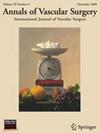超声引导下经皮与开放式肱动脉入路的安全性和有效性:多中心前瞻性 ARCHIBAL 研究经皮/开放式肱动脉入路的结果。
IF 1.4
4区 医学
Q3 PERIPHERAL VASCULAR DISEASE
引用次数: 0
摘要
背景:尽管肱动脉入路在经皮血管内手术中的应用越来越广泛,但文献中对开放式(OBA)和超声引导下经皮(PBA)肱动脉入路的正面比较结果却很有限。我们的多中心、前瞻性、非介入性 ARCHIBAL 研究旨在比较 OBA 和 PBA 进行外周动脉介入的安全性和有效性:从 2019 年 7 月到 2021 年 1 月,14 个中心的 15 名外科医生连续将所有需要通过肱动脉入路进行外周血管内手术的患者纳入研究。手术使用 4F-8F 导入鞘完成。OBA采用常规动脉缝合,PBA采用压迫或血管闭合装置进行动脉闭合。主要终点是术后 30 天内发生入路部位并发症的比率。次要终点是不良事件的发生率以及肱动脉通路插管的临床成功率和技术成功率:在纳入的 251 名患者(平均年龄 69.9 岁,男性占 70.5%)中,122 人(48.6%)采用 OBA,129 人(51.4%)采用 PBA,基线人口统计学和临床特征无显著差异。38.6%的患者接受了一种以上适应症的手术。所有患者都取得了临床成功,244 名患者(97.2%)取得了技术成功。无死亡、脑部、心脏或栓塞并发症报告。PBA组(8/1296.2%)的入路部位并发症(主要是血肿)明显(P=0.02)多于OBA组(1/125,(0.8%),或者当OBA使用的导引鞘>6F或PBA使用的血管闭合器时:我们的前瞻性研究证实了肱动脉入路的安全性和有效性,并表明即使是在超声引导下由训练有素的外科医生进行肱动脉入路手术,OBA 与 PBA 相比在安全性方面也有优势。这鼓励在使用 PBA 时使用 OBA 和超声引导。应开展大型和/或随机研究来支持这些结果。本文章由计算机程序翻译,如有差异,请以英文原文为准。
Safety and Effectiveness of Ultrasound-Guided Percutaneous Versus Open Brachial Artery Access: Results of the Multicenter Prospective ARCHIBAL Study Percutaneous or Open Brachial Artery Access
Background
Although brachial access (BA) has become increasingly used in percutaneous endovascular procedures, results from head-to-head comparisons between open brachial access (OBA) and ultrasound-guided percutaneous brachial access (PBA) are limited in the literature. The objective of our multicenter, prospective, noninterventional ARCHIv BrachiAL study was to compare the safety and efficacy of OBA and PBA to perform peripheral arterial interventions.
Methods
From July 2019 to January 2021, all patients needing peripheral endovascular procedures with brachial artery access were consecutively included in the study by 15 surgeons in 14 centers. Procedures were done with 4F-8F (French gauge) introducer sheaths. Arterial closure was done by conventional arterial sutures for OBA and compression or vascular closure devices for PBA. The primary endpoint was the rate of access site complications occurring up to 30 days postoperatively. Secondary endpoints were the occurrence of adverse events and the overall rates of clinical success of BA cannulation and technical success.
Results
Among the 251 included patients (mean age, 69.9 years; males 70.5%), 122 (48.6%) had an OBA and 129 (51.4%) had a PBA, without significant differences in baseline demographic and clinical characteristics. 38.6% of the patients had the procedure for more than one indication. Clinical success was achieved in all patients and technical success in 244 patients (97.2%). No death, cerebral, cardiac, or embolic complications were reported. Access site complications (primarily hematomas) were significantly (P = 0.02) more frequent in the PBA (8/129; 6.2%) than the OBA group (1/122; 0.8%) or when using introducer sheaths >6F for OBA or vascular closure devices for PBA.
Conclusions
Our prospective study confirmed the safety and effectiveness of BA and showed the benefit in terms of safety of OBA versus PBA even when PBA was ultrasound-guided and performed by trained surgeons. It encourages the use of OBA and ultrasound guidance when using PBA. Large and/or randomized studies should be performed to support these results.
求助全文
通过发布文献求助,成功后即可免费获取论文全文。
去求助
来源期刊
CiteScore
3.00
自引率
13.30%
发文量
603
审稿时长
50 days
期刊介绍:
Annals of Vascular Surgery, published eight times a year, invites original manuscripts reporting clinical and experimental work in vascular surgery for peer review. Articles may be submitted for the following sections of the journal:
Clinical Research (reports of clinical series, new drug or medical device trials)
Basic Science Research (new investigations, experimental work)
Case Reports (reports on a limited series of patients)
General Reviews (scholarly review of the existing literature on a relevant topic)
Developments in Endovascular and Endoscopic Surgery
Selected Techniques (technical maneuvers)
Historical Notes (interesting vignettes from the early days of vascular surgery)
Editorials/Correspondence

 求助内容:
求助内容: 应助结果提醒方式:
应助结果提醒方式:


